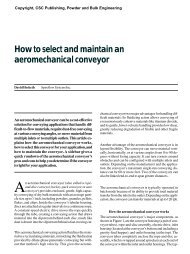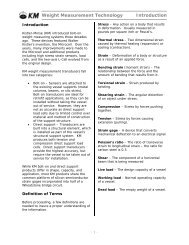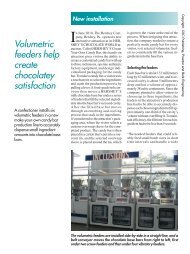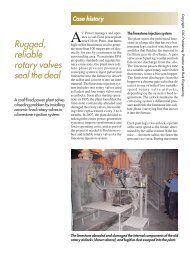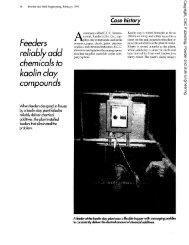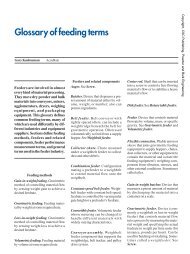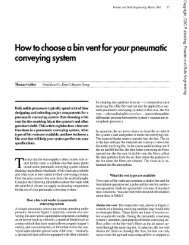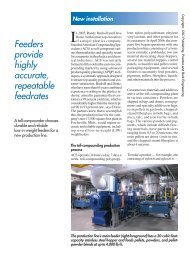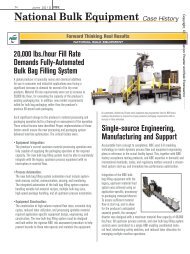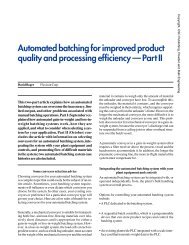Screener troubleshooting: Diagnosing and solving screen problems
Screener troubleshooting: Diagnosing and solving screen problems
Screener troubleshooting: Diagnosing and solving screen problems
You also want an ePaper? Increase the reach of your titles
YUMPU automatically turns print PDFs into web optimized ePapers that Google loves.
Antiblinding devices, like the sliders shown here,<br />
help prevent particles from sticking in the <strong>screen</strong><br />
openings.<br />
Over time, many antiblinding devices wear <strong>and</strong> lose their<br />
effectiveness. Proper monitoring <strong>and</strong> maintenance of the<br />
devices will keep your <strong>screen</strong>s clear <strong>and</strong> free from blinding.<br />
Material bypass is another common cause of <strong>screen</strong> <strong>problems</strong>.<br />
Material bypass happens when something causes<br />
the <strong>screen</strong> mesh to separate from its frame, allowing material<br />
to pass between the mesh <strong>and</strong> the frame, or — less<br />
often — when the gasket or seal between the <strong>screen</strong> deck<br />
<strong>and</strong> the <strong>screen</strong>er housing fails, allowing material to pass<br />
between the <strong>screen</strong> deck <strong>and</strong> the housing. The latter problem<br />
doesn’t occur often; the seal or gasket between the<br />
<strong>screen</strong> deck <strong>and</strong> <strong>screen</strong>er housing is usually reliable. But<br />
certain methods of attaching the mesh to its frame are<br />
more likely to allow material bypass.<br />
Commonly, <strong>screen</strong> mesh is attached to the <strong>screen</strong> frame by<br />
clips or bolts. These are placed at regular intervals around<br />
the <strong>screen</strong> frame, <strong>and</strong> an operator in your plant or the<br />
<strong>screen</strong> manufacturer’s plant manually attaches the mesh to<br />
each clip or bolt. In the spaces between the clips or bolts,<br />
the mesh isn’t attached to the frame, but the <strong>screen</strong> tension<br />
effectively seals the mesh to the frame. If the <strong>screen</strong> is mish<strong>and</strong>led,<br />
the mesh isn’t attached to the frame properly or<br />
maintained properly, or a clip or bolt fails, the mesh can<br />
come away from the frame, leaving a hole that material<br />
can pass through.<br />
<strong>screen</strong> maintenance starts with regular inspections. Depending<br />
on your application, these might be done every<br />
hour, every shift, every week, or at another regular interval.<br />
Look for tears, signs of blinding, <strong>and</strong> gaps between the<br />
<strong>screen</strong> mesh <strong>and</strong> frame.<br />
In addition to finding immediate <strong>problems</strong>, regular inspections<br />
can give you the information you need to take preemptive<br />
action to prevent <strong>screen</strong> failure during processing,<br />
which will require you to shut down your process while<br />
you change <strong>screen</strong>s. For example, if your inspections<br />
show that a <strong>screen</strong> typically lasts 9 weeks, you can change<br />
the <strong>screen</strong> after 7 or 8 weeks during scheduled downtime<br />
<strong>and</strong> avoid the interruption to your process. Or, if your material<br />
has corroded the <strong>screen</strong>, you can replace it with a<br />
<strong>screen</strong> made of mesh of a different steel alloy or a synthetic<br />
material.<br />
After inspecting the <strong>screen</strong>, clean it off if needed. The<br />
cleaning method will depend on your material <strong>and</strong> process<br />
<strong>and</strong> can range from light brushing of dry, lightweight particles<br />
to power-washing of heavy or cohesive particles from<br />
the <strong>screen</strong>.<br />
PBE<br />
Reference<br />
1. For detailed information on how to properly select a <strong>screen</strong>, see<br />
“Choosing a woven wire <strong>screen</strong> for top separation performance,”<br />
Powder <strong>and</strong> Bulk Engineering, December 2006, page 17.<br />
For further reading<br />
Find more information on <strong>screen</strong>s <strong>and</strong> <strong>screen</strong>ers in articles<br />
listed under “Screening <strong>and</strong> classifying” in Powder <strong>and</strong><br />
Bulk Engineering’s comprehensive “Article index” at<br />
www.powderbulk.com <strong>and</strong> in this issue.<br />
Copyright, CSC Publishing, Powder <strong>and</strong> Bulk Engineering<br />
If you want to be sure material bypass can’t occur, you can<br />
purchase pretensioned <strong>screen</strong>s.These <strong>screen</strong>s are assembled<br />
at the manufacturer’s plant <strong>and</strong> the mesh is epoxied to the<br />
<strong>screen</strong> frame’s entire circumference, making it impossible<br />
for the mesh to come away from the frame <strong>and</strong> form a gap.<br />
Screen maintenance<br />
While it’s true that practically all <strong>screen</strong>s will fail if left to<br />
operate indefinitely, any <strong>screen</strong>’s service life can be maximized<br />
through proper selection <strong>and</strong> maintenance. Proper<br />
Jeff Dierig is global marketing manager at Sweco, 8029<br />
US Highway 25, Florence, KY 41042; 800-807-9326 or<br />
859-727-5116, fax 859-727-5122 (jeff.dierig@sweco.com,<br />
www.sweco.com). He holds a BA in marketing <strong>and</strong> an<br />
MBA, both from Northern Kentucky University in Highl<strong>and</strong><br />
Heights, <strong>and</strong> has more than 14 years experience with<br />
bulk solids processing equipment.





